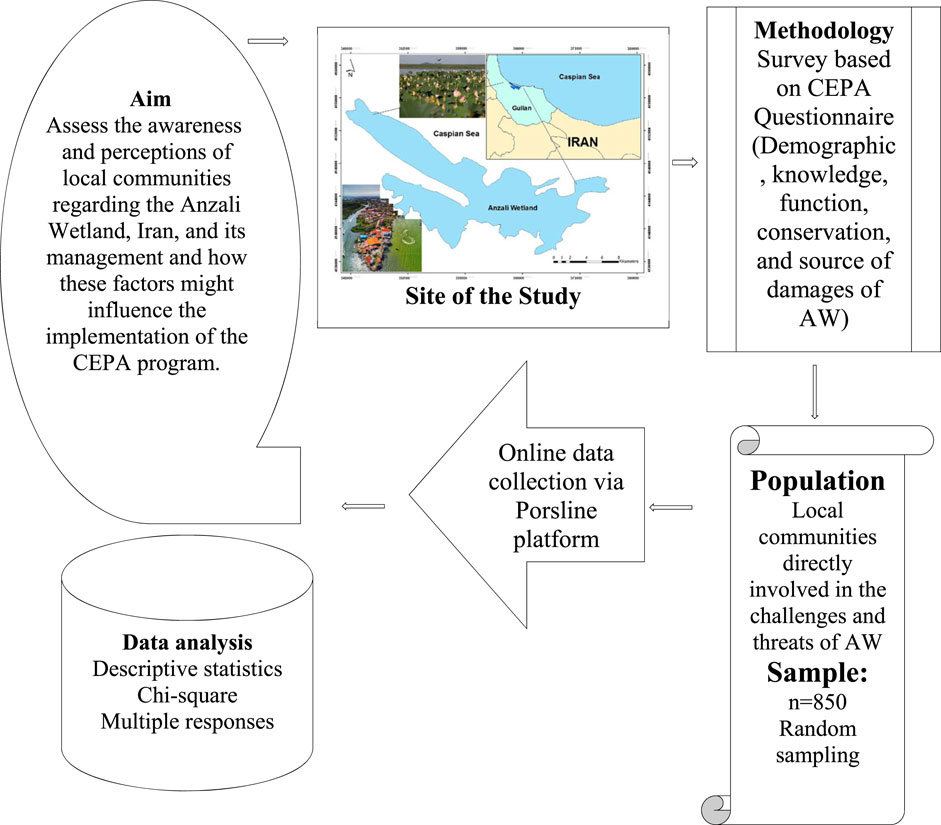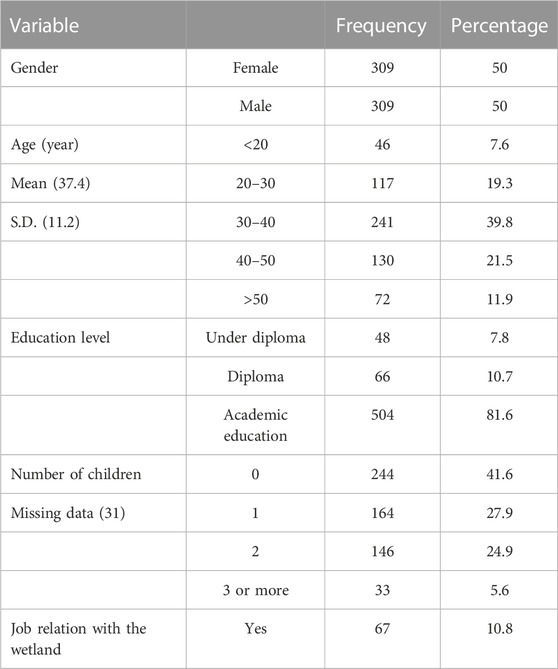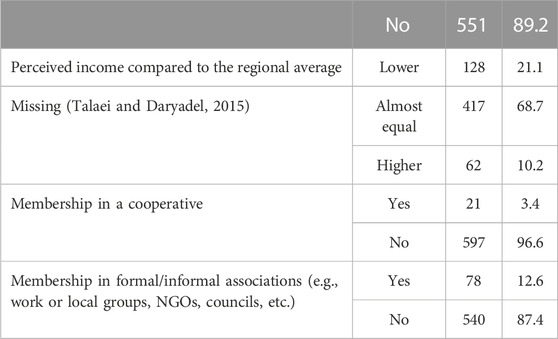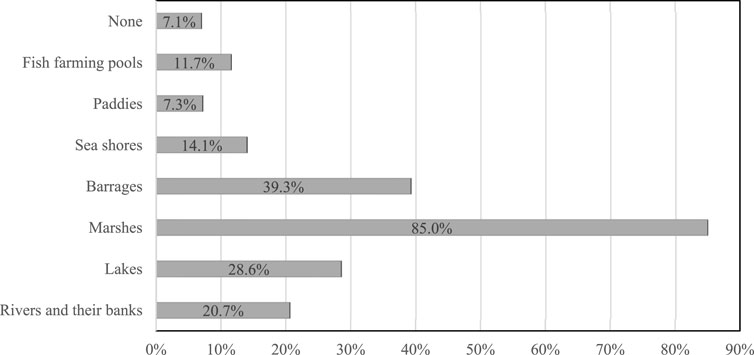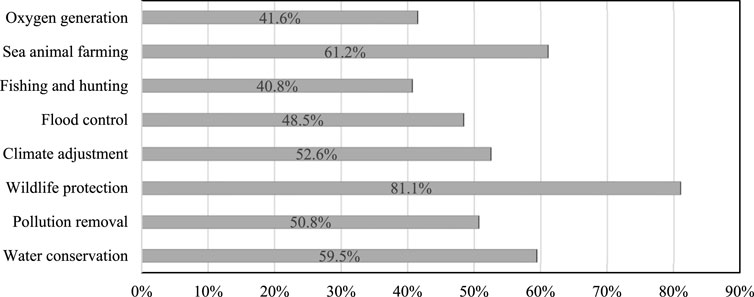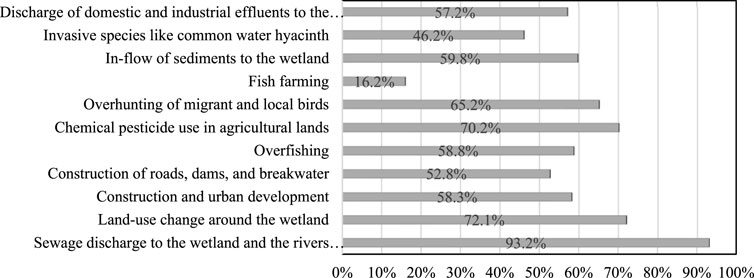Unlocking the power of public awareness: paving the way for sustainable wetland management in Anzali, Iran
- 1Agricultural and Rural Development and Economy Research Center, Rasht Branch, Islamic Azad University, Rasht, Iran
- 2Faculty of Economic and Management Sciences, North-West University, Mmabatho, South Africa
- 3Department of Agricultural Extension and Education, School of Agriculture, Shiraz University, Shiraz, Iran
- 4The BEAM Research Centre, School of Computing, Engineering and Built Environment, Glasgow Caledonian University, Glasgow, United Kingdom
- 5Department of Agricultural Extension, Communication and Rural Development, School of Agriculture, Zanjan University, Zanjan, Iran
- 6Program of Policy, Planning, and Development, Department of International Affairs, College of Arts and Sciences, Qatar University, Doha, Qatar
The Anzali Wetland, located in the Guilan Province of Iran, is a vital ecosystem with significant ecological value. However, it faces numerous environmental challenges due to pollution, habitat degradation, and unsustainable resource use. This paper aims to assess the awareness and perceptions of local communities regarding the Anzali Wetland, Iran, and its management and how these factors might influence the implementation of the CEPA program. A quantitative survey based on a structured questionnaire was designed and administered to local communities within the wetland’s watershed. The data were analyzed using descriptive statistics. The results indicate that local communities have limited knowledge about the wetland, often associating it solely with Anzali Lagoon. Despite this lack of awareness, most participants recognize the wetland’s importance in conserving wildlife. Further, participants identified domestic and industrial wastewater pollution as the most significant threat to the wetland. Additionally, education at the school level, the Internet, and virtual networks were perceived as effective means of raising awareness among the local population. The study highlights the importance of increasing public participation and interaction among different social groups to enhance awareness of the wetland’s value and environmental issues. It also emphasizes the need for coordinated efforts among stakeholders in wetland management and policy-making, including government agencies and civil organizations. By examining the significance of public awareness in the Iranian context, the study provides unique insights into wetland conservation efforts in a specific geographical and ecological setting. Furthermore, by considering the perceptions and opinions of these stakeholders, the study offers a holistic understanding of the diverse perspectives and interests related to wetland conservation, which adds depth and richness to the analysis.
1 Introduction
Wetlands are widely acknowledged on a global scale as essential for maintaining ecological equilibrium and ensuring the existence of human populations. They provide invaluable services crucial to our planet’s overall wellbeing. Wetlands serve as vital centers for biodiversity, playing a pivotal role in regulating water systems, carbon sequestration, and promoting economic development. These ecosystems support and maintain natural environments and substantially benefit human societies (Janse et al., 2019). Wetlands are also regarded as crucial systems for achieving the Sustainable Development Goals of the United Nations (SDGs) (Jaramillo et al., 2019; The Convention on Wetlands, 2023). However, wetlands face various challenges worldwide, including urbanization, land conversion for agriculture and infrastructure development, shifts in temperature and rainfall, etc. These challenges have led to a significant decline in wetland areas over the past century (Davidson, 2014; Calhoun et al., 2017), making the sustainability of these ecosystems a considerable concern.
Amidst this backdrop, the Ramsar Convention’s Programme on Communication, Capacity Building, Education, Participation, and Awareness (CEPA) was adopted in 1999 (Resolution VII.9) and renewed in 2002, 2008, and 2015 (Karanja et al., 2018). The CEPA is a 9-year strategy (2016–2024) to promote wetland conservation by raising awareness and changing stakeholders’ perceptions of wetlands declared as Ramsar sites (Karanja et al., 2018; Shah, 2021). Accordingly, several governments strive to adopt the CEPA program to balance the environmental, economic, social, and political relationships between stakeholders (i.e., public, private, non-government organizations, and civil The limited perspective expressed here deviates from the holistic viewpoint promoted by the CEPA initiative. The need for comprehensive wetland education, which encompasses both traditional knowledge and the broader ecological relevance, has been emphasized in previous scholarly works. Given the challenges wetlands face worldwide, implementing the CEPA program in specific wetland sites, such as Anzali Wetland in Iran, becomes even more crucial in promoting their conservation and sustainable management.
Anzali Wetland is one of the most important freshwater bodies in the southern Caspian Sea region in the Guilan Province of Iran, experiencing severe environmental issues. This unique wetland environment supports biodiversity, provides a home for migrating birds, and contributes to the local economy via fishing and tourism. It is also one of Iran’s most prominent rice-growing areas (Aghsaei et al., 2020). Nonetheless, due to the unsustainable use of resources, the discharge of industrial, domestic, and agricultural effluents, water abstraction for irrigation, urban sprawl, and increasing land degradation, the ecological integrity of Anzali Wetland is under severe threat with pollution, sedimentation, invasion of exotic species, and eutrophication during the last few decades (Mirzajani et al., 2010; Jafari et al., 2016).
Communication, education, and public awareness (CEPA) are essential for motivating individuals to engage in innovations, like ecosystem management. They involve information exchange, dialogue, and education. The current lack of concern may stem from insufficient CEPA efforts, emphasizing its role in inspiring interest and participation in innovative initiatives. The highlighted importance of Communication, Education, and Public Awareness (CEPA) lays the groundwork for practical conservation activities in the Anzali Wetland. Recognizing CEPA’s critical function opens the door to rethinking and enhancing tactics for encouraging long-term relationships in this vulnerable environment. Acknowledging the crucial role CEPA plays allows for a reassessment and enhancement of the approaches designed to promote sustainable engagement with this vulnerable ecosystem (Karanja et al., 2018; Shah, 2021).
Consequently, the Anzali Wetland has been registered in the Montreux Record of Ramsar Convention as a wetland with high ecological changes (Talaei and Daryadel, 2015). Further, the Guilan Department for the Environment planned to develop and implement the CEPA program in the Anzali Wetland. In addition to all other actions and activities, the development and implementation of the CEPA program may play an important role in enhancing people’s and stakeholders’ awareness of the wetland’s values and threats (Allahyari et al., 2022a). Further, the CEPA can help governments design holistic approaches to solve wetland environmental issues, such as pollution or biodiversity loss (Hesselink et al., 2007). However, humans have often transformed wetlands unsustainably due to a negative attitude toward them, as well as limited awareness about their value and techniques by which they can be utilized sustainably (Polajnar Horvat and Smrekar, 2021).
Subsequently, according to the goals of the CEPA program, identifying stakeholders and local communities to assess their awareness of wetlands is essential (Abedi and Hosseini, 2021). The CEPA program also recognizes the critical importance of public awareness as a driving factor behind its success, emphasizing the need to successfully communicate the values and functions of wetlands to stakeholders and empower them to engage actively in conservation efforts (Dalu et al., 2022). Therefore, to plan the CEPA program for the Anzali Wetland, assessing public awareness and attitudes towards the wetland can better understand the community’s needs and develop an effective educational program to build capacity in wetland utilization and protection.
Over the past 2 decades, there has been an increase in the number of governance strategies used in wetlands management, whether on state, regional, or municipal initiatives (Polajnar Horvat and Smrekar, 2021). Although no unified model or policy exists for effective wetland governance, most approaches highlight the importance of stakeholders’ participation. As Newig and Fritsch (Newig and Fritsch, 2009) emphasized, “current political trends and scholarly research increasingly promote collaborative and participatory governance in multi-level systems as a way to more sustainable and effective environmental policy” (p. 197). Exclusion of the local community can result in various conflicts and problems, making it highly challenging to implement sustainable conservation policies for wetlands (Obradović et al., 2023). However, stakeholders’ engagement in planning decisions is inextricably tied to their understanding and awareness of the issues. When they know the challenges, benefits, and potential consequences of planning decisions, they are better equipped to participate in the decision-making process actively. Several factors influence public awareness regarding environmental issues, including wetlands. These factors can be categorized into individual-level (age, education, experience, etc.) and societal-level influences (socio-economic conditions, social networks, government policies, community initiatives, etc.) (Obradović et al., 2023).
Despite the critical significance of Iran’s Anzali Wetland and its numerous environmental challenges, studies concentrating specifically on this unique ecosystem are rare. Only a few studies have been conducted to investigate the ecological, socio-economic, and conservation aspects of Anzali Wetland in depth (Mirzajani et al., 2010; Japan International Cooperation Agency, 2012; Talaei and Daryadel, 2015; Abedini et al., 2018; Aghsaei et al., 2020; Mirzajani et al., 2021). Therefore, no study has specifically investigated the CEPA program and public awareness in the context of Anzali Wetland. This scarcity of studies creates a significant knowledge and understanding gap regarding the dynamics, functioning, and efficacy of wetland conservation initiatives, further emphasizing the significance and originality of this study.
Hence, the novelty of this research is twofold. First, our research delves deep into the unique intricacies of the Anzali Wetland, a critical environmental and socio-economic value ecosystem severely underrepresented in the existing literature. Second, our study is innovative in its approach to assessing the local community’s awareness and perceptions of wetland management and the consequences of CEPA program implementation. Such a synthesis of localized ecological understanding and programmatic effectiveness, particularly in the Iranian context, provides new insights and valuable knowledge, improving both academic and practical discourses on wetland conservation.
Accordingly, this paper aims to assess the awareness and perceptions of local communities regarding the Anzali Wetland, Iran, and its management and how these factors might influence the implementation of the CEPA program. It sought to answer this main research question: To what extent are communities and other stakeholders aware of, and do they perceive the definitions, functions, characteristics, and threats to the Anzali Wetland, Iran? These responses led the CEPA programming team to conduct a more appropriate wetland program. We will discuss the research methodology in Section 2 and present the study results in Section 3. The results will then be examined and discussed before we present the main conclusions.
2 Materials and methods
The following flowchart provides a concise overview of the study’s aim, methodology, target population, and data analysis approach, all centered around the conservation of the Anzali Wetland (Figure 1).
2.1 Study site
The Anzali International Wetland, a Ramsar site, is located in the northern part of Iran and the southwest of the Caspian Sea, approximately between 36◦550 and 37◦320 N and 48◦450 and 49◦420 E, in the counties of Bandar Anzali, Sowme’eh Sara, and Rasht (The, 2005). The wetland is a large water body with an area of 195 km2, a length of 33 km, and a width of 11 km. It is fed by 10 large rivers (Department of Environment, 2022). The Anzali Wetland is linked to the Caspian Sea by its only exit at the Ports and Maritime Administration of Guilan Province (Figure 2). The Anzali Wetland is divided into four sections/zones: central, western (Great Wetland), eastern, and Siah-Keshim. The water level and salinity in the Anzali Wetland are greatly influenced by the rivers’ freshwater and the Caspian Sea’s salt water, leading to a unique ecotone (Abedini et al., 2018).
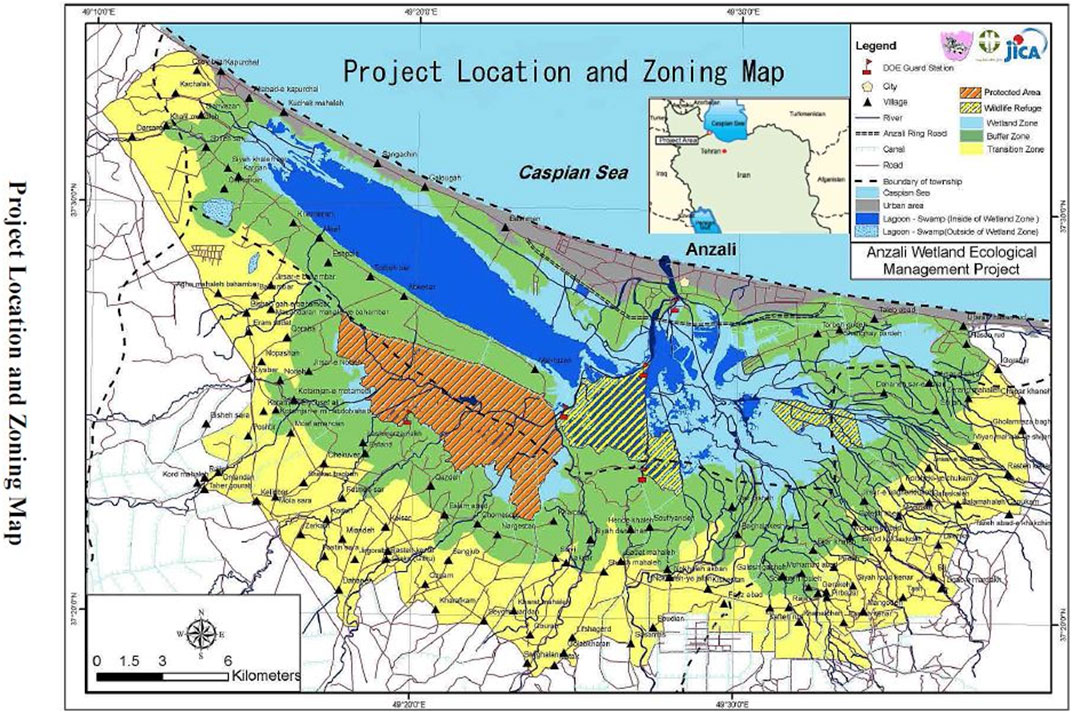
FIGURE 2. The geographical location of the Anzali Wetland. Source: JICA (The, 2005).
The wetland encompasses various habitats, including marshes, lagoons, and shallow water areas. It is a critical ecological resource, providing many valuable services and functions. It plays a pivotal role in water regulation, acting as a natural filter and reservoir, as well as maintaining the local hydrological balance. It is also a sanctuary for numerous plant and animal species, including migratory birds and fish, showcasing rich biodiversity (Mirzajani et al., 2021). Moreover, the wetland supports the livelihoods of local communities through activities such as fishing, agriculture, aquaculture, and tourism. In addition, a review of satellite land-use data from 2013–2014 reveals that forest land use accounts for 53% of wetland lands, 25% for agriculture, 6.2% for residential and urban land use, and wetland, barrage, or other land-use accounts for 5.4%. In addition, residential areas increased by 1.1%, while wetland areas decreased by 0.2% in 2013–2014. However, despite its ecological significance, Anzali Wetland faces several environmental challenges, including pollution, habitat degradation, the accumulation of sediment, the discharge of various types of sewage effluents (including domestic, agricultural, and industrial), and the generation of waste stemming from various economic activities (Sadeghi Pasvisheh et al., 2021). These detrimental factors collectively threaten the integrity and long-term sustainability of the wetland ecosystem.
The management of Anzali Wetland and the CEPA Program involves collaborating and engaging various stakeholders who play vital roles in the decision-making and implementation of conservation measures. Firstly, the main stakeholder is the Guilan Department of Environment, which led the project of developing the CEPA program with the cooperation of the Agricultural and Natural Resources Engineering System Organization of Guilan province. Secondly, many representatives of public and private sector stakeholders are also involved in the wetland, such as civil institutions, local communities, beach seine fishing cooperatives, barrage owners, etc.
The population in the Anzali Wetland basin totals approximately 1,221,056 individuals. The wetland holds significant ecological, economic, and social value for the three counties of Rasht, Bandar Anzali, and Sowme’eh Sara. Each of these counties utilizes the wetland differently, influenced by geographical location, economic activities, and cultural practices. As of 2016–2017, Rasht County had a total population of 957,971 residents, consisting of 478,678 males and 478,293 females. Bandar Anzali’s population amounted to 139,016 individuals, with 69,228 males and 69,788 females. In Sowme’eh Sara County, the gender ratio is 99 in urban areas and 101 in rural areas. The overall population of this county is 125,074, with 62,317 males and 62,757 females. More than 80% of the population in these areas are educated (Table 1).

TABLE 1. The demographic profile of urban and rural areas in the counties of Rasht, Bandar Anzali, and Sowme’eh Sara (2016–2017).
According to the definitions of the Statistics Organization of Iran, the active population is all household members of 10 years and older who were employed or unemployed in the 7 days before the census, are called the active population. Students, housewives, and unemployed income earners who have been employed or unemployed are considered among the active population. Also, according to the definition of work, all people 10 years old and older who have worked for at least 1 hour during the reference week or who have temporarily left work for some reason are considered employed. The occupation profile shows the percentage of the employed population at the working age. Based on the results, the employment rate of the population aged 10 years or older is 87% in Rasht, 82% in Bandar Anzali, and 83% in Sowme’eh Sara (Table 2).
Furthermore, the analysis of satellite land-use data for the years 2013–2014 reveals that 53% of the wetland lands are classified as forest land use, 25% as agricultural land use, 6.2% as residential and urban land use, and 5.4% as wetland, barrage, or other land uses. It is also noteworthy that residential areas expanded by 1.1%, while wetland areas decreased by 0.2% during 2013–2014 (Allahyari et al., 2022a).
2.2 Data collection and analysis
This research is a qualitative study that aims to describe and interpret data using the survey method. The study is based on a qualitative paradigm, emphasizing subjective data interpretation. The survey method is used to collect data from participants and gain insights into their knowledge, opinions, and awareness. The population was the local communities residing within the watershed of the Anzali Wetland, as they play a significant role as end-user stakeholders directly involved in the challenges and threats faced by the Anzali Wetland in Gilan province. Based on the minimal sample size chart provided by Bartlett et al. (Bartlett et al., 2001), the statistical sample for this survey was calculated to be 370. However, to improve the research’s external validity, a total of 850 questionnaires were disseminated during about a month (3 Nov 2020 to 27 Nov 2020) through various channels. The survey was available online via prominent platforms like social media and the dedicated website: http://porsline.ir. Additionally, the questionnaire was distributed in person during engaging participatory workshops within schools, environmental associations, and student groups. Moreover, face-to-face interactions allowed us to personally administer questionnaires to select residents residing in villages neighboring the wetland. Questionnaires were distributed by traditional means, such as postal mail, to residents living in cities within the Anzali Wetland’s vicinity to ensure inclusivity. Before the survey distribution, respondents were informed of its purpose. Participation was voluntary, and all data was anonymized to ensure privacy. Finally, 618 viable questionnaires (with a 72% response rate) were included in the final analysis.
The questionnaire comprised two distinct sections. The first section focused on gathering essential demographic data from the participants, such as age, gender, education level, occupation, job relation with the wetland, membership or not in a cooperative, etc. Given that some individuals held multiple jobs due to economic conditions, a multiple-response method with dichotomous answers was employed to assess the contribution of the respondents. Because specific questions were ethical and personal, like those related to income and the number of children, we decided to make responding to these questions on the survey platform optional. As a result, some individuals chose not to answer these questions, and these omissions were recorded as missing data in the findings.
The second section of the questionnaire was specifically designed to delve deeper into the participants’ knowledge and understanding of the Anzali Wetland. It aimed to assess their familiarity with key aspects such as the wetland’s definition, functions, problems, threats, awareness-raising paths, the role of the media, and influential organizations involved in its conservation. For instance, participants were asked to define a wetland and explain the Anzali Wetland’s specific functions, highlighting its ecological importance and the ecosystem services it provides (Table 3). Questions were gathered using dichotomous responses of multiple-response methods.
Several steps were required to ensure the validity and reliability of the questionnaire during its construction. First, a comprehensive review of the pertinent literature was conducted to identify key themes and variables associated with wetland awareness and perceptions. Second, researchers and professionals with expertise in wetland management and environmental studies were consulted. The panel provided valuable insights and feedback On the questionnaire’s structure, content, and wording. Their feedback assisted in refining and ensuring the questionnaire’s relevance and thoroughness.
Before the widespread distribution of the questionnaire, a pilot study was undertaken to assess the clarity, comprehensibility, and relevance of the questionnaire items. A small sample of 25 individuals representing the target population was requested to complete the questionnaire and provide feedback on its structure, wording, and overall coherence. This feedback was invaluable in identifying any ambiguities, inconsistencies, or potential improvements in the questionnaire design. Additionally, participants were encouraged to share their insights and suggestions for enhancing the questionnaire’s effectiveness in capturing the intended information.
Descriptive statistics were employed to provide a comprehensive overview and analysis of the participants’ characteristics and their level of awareness regarding the issues outlined earlier. These statistics allowed us to summarize and present the data meaningfully and concisely. Firstly, demographic characteristics such as gender, age, education, occupation, and civic participation were analyzed using descriptive statistics. Measures such as minimum and maximum values were used to determine the range of ages and educational levels within the sample. Furthermore, descriptive statistics were employed to analyze the participants’ awareness levels of the issues above. For example, in assessing their understanding of wetland functions, descriptive statistics allowed us to determine the percentage of participants correctly identifying these functions. Multiple-response cross-tabulation analysis was also utilized to explore participants’ familiarity with influential organizations, identifying the percentage of participants who recognized the roles of governmental agencies, NGOs, research institutions, and international bodies.
3 Results
3.1 Sociodemographic characteristics of the study participants
The findings revealed a balanced representation of both male and female participants, with an equal number of individuals from each gender. Further, a significant proportion (40%) of the participants were 30–40. Most participants (82%) had an academic degree, and more than half (53%) had one or two children (Table 4). Also, The multiple-response analysis results show that 41% of the participants held employment positions within government agencies or the private sector. In comparison, approximately 10% were engaged in occupations directly linked to the wetland (Table 4). Regarding income, a significant majority (60%) of the respondents fell within a similar income bracket. Additionally, a mere 3% of the participants identified themselves as members of fishing, agricultural, or rural cooperatives, indicating limited representation from these specific sectors. Moreover, the engagement of respondents in formal or informal organizations, working groups, or civil organizations was relatively low, with only about 13% reporting active involvement (Table 5).
3.2 Participants’ knowledge of the wetland’s characteristics
The analysis of the results revealed a noticeable lack of comprehensive knowledge among the participants regarding the wetland. Evidently, their understanding of the wetland was often limited to a traditional perspective, considering it primarily synonymous with the Anzali Lagoon. Indeed, local communities residing near the lagoon, particularly those living on the southern and eastern peripheries, continue to refer to it as “Mord-e Ab,” a term that translates to “dead water.” Similarly, in the past, residents from the northern margin of the wetland, which is close to the sea, used to designate the Anzali Wetland as “Koji Darya,” signifying a “small sea,” in contrast to the “Pil-e Darya,” meaning the “large sea,” referring to the Caspian Sea (Figure 3).
Further, approximately 50% of the respondents demonstrated awareness regarding the multifaceted functions of the wetland, with a significant majority (81%) acknowledging its pivotal role in safeguarding wildlife. Considering the predominant livelihood practices within the study area and the respondents’ proximity and familiarity with the region, aquaculture, and fishing emerged as additional salient functions of the wetland as perceived by the participants. This attests to the participants’ recognition of the wetland’s significance in supporting socio-economic activities intertwined with the local communities’ way of life (Figure 4).
The findings indicate a significant level of understanding among the general public regarding the challenges faced by the wetland, suggesting a foundation of knowledge that can be enhanced through increased public engagement and interaction among diverse social groups. Moreover, a significant proportion of the respondents (more than half) exhibited awareness regarding the sources of pollutants and detrimental factors affecting the wetland. Notably, over 90% of the participants identified the discharge of domestic and industrial wastewater as the leading pollutant and threat to the wetland (Figure 5).
Further, the findings indicate that, based on participant responses, key channels for increasing awareness among residents within the Anzali Wetland watershed include education at the school level (56%), utilization of the Internet and virtual networks (51%), radio and television broadcasting (41%), the establishment of local groups (42%), and education and extension activities in rural areas (38%) (Figure 6). These results provide valuable insights into the most influential communication channels and highlight their significance in planning initiatives to extend and enhance public awareness.
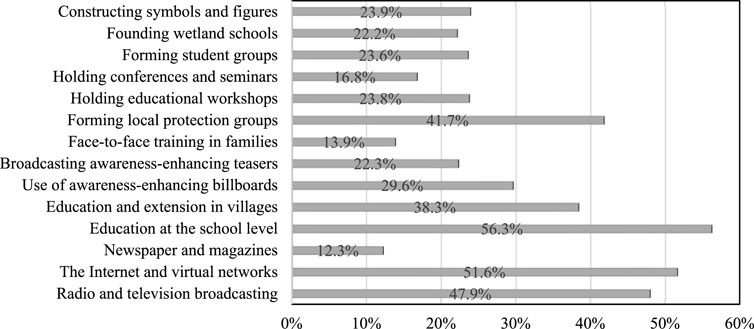
FIGURE 6. Effective media in raising the awareness of the residents within the watershed of the Anzali Wetland.
In terms of stakeholder effectiveness in the management of the Anzali Wetland, the participants indicated that the Department of Environment (82%) and the Department of Natural Resources and Watershed Management (65%) were considered the primarily responsible entities (Figure 7).
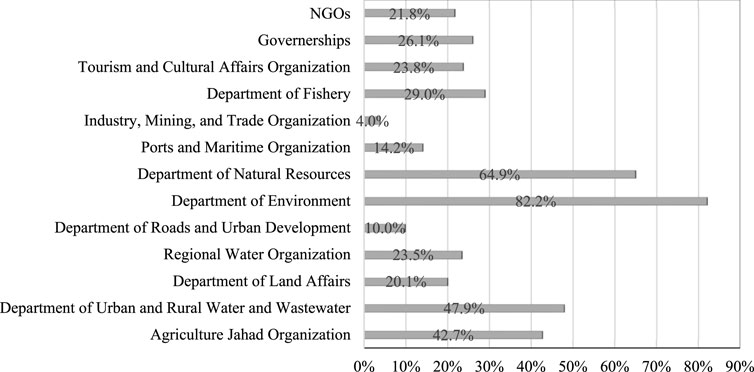
FIGURE 7. The effectiveness of stakeholders in the management of the Anzali Wetland from the perspective of respondents.
Further, notable patterns emerged when examining the age groups concerning the functions of the wetland and the effective media for disseminating information to society. Across all age groups, a strong emphasis was placed on “protecting the wetland wildlife” as the most significant function. However, when considering the second most crucial function, the age group under 20 identified water protection as their top priority after wildlife protection, followed by aquaculture and pollution mitigation. In contrast, the age group between 20 and 30 years ranked aquaculture as the second most important function of the wetland, followed by water protection and the regulation of climatic conditions in the third and fourth positions, respectively.
Furthermore, the findings obtained from the age group ranging from 30 to 40 years exhibited a similar trend to the 20–30 age group. The only discernible distinction was a slightly higher emphasis on water protection’s importance than aquaculture. Conversely, the age group between 40 and 50 identified aquaculture and pollution mitigation as the second most crucial wetland functions, following wildlife protection. From the standpoint of the respondents aged over 50 years, water protection garnered the second highest ranking, while aquaculture held the third position with a marginal variation, and pollution elimination secured the fourth rank. These findings signify that all age groups are reasonably familiar with the various functions associated with the wetland, as evidenced by the relative rankings across different age cohorts (Table 6).

TABLE 6. Perceptions and preferences of different demographic groups on wetland functions and awareness-raising methods.
Regarding the efficacy of various media channels in wetland protection, divergent outcomes were observed among distinct age groups. The age cohorts of <20 and 20–30 years identified the Internet and virtual networks as the most effective means for enhancing public awareness. Conversely, the age groups of 30–40 and 40–50 years assigned greater significance to education at the school level. Notably, respondents aged over 50 years emphasized the role of radio and television broadcasting as the most influential media in disseminating information on wetland conservation.
The age group of individuals below 20 years of age ranked radio and television broadcasting as the second most effective means for raising awareness and education at schools as the third. In contrast, the age group of 30–40 years placed education at schools in the second rank and radio and television broadcasting in the third. Additionally, the age group of 30–40 years acknowledged the Internet and virtual networks as the second most influential channels for enhancing public awareness while assigning the third rank to radio and television broadcasting in terms of disseminating information related to the values, functions, and protection of the wetland.
The age group consisting of individuals between 40 and 50 years of age assigned the formation of protection groups as the second most influential factor in raising awareness, followed by education and extension in rural areas, radio and television broadcasting, and virtual networks in subsequent ranks. In comparison, respondents over the age of 50 years emphasized the efficacy of education at schools and education and extension in rural areas as the primary means for enhancing awareness. These findings provide valuable insights into the preferences and influences of distinct demographic groups, facilitating more targeted and effective strategies for promoting awareness.
There were marginal differences in the perspectives of males and females regarding the wetland’s functions, with both genders expressing broadly similar opinions. According to the results, the primary function of the wetland, as perceived by both males and females, is the protection of wildlife, followed by aquaculture and the preservation of water resources in subsequent ranks. However, females tended to assign less importance to fishing and hunting than males. Conversely, a few males identified oxygen production as an additional function of the wetland. These findings are summarized in Table 2 and shed light on the subtle variations in viewpoints between genders concerning the multifaceted roles of the wetland.
There is a notable similarity in the perspectives of males and females regarding the media and strategies for enhancing public awareness, as both groups place importance on education at schools, the Internet and virtual networks, radio and television broadcasting, and the establishment of local groups, respectively (Table 6). Consequently, it can be inferred that the awareness of both genders can be enhanced through similar approaches. However, it is crucial to diversify the methods employed and ensure repetition to maximize the effectiveness of training initiatives.
Unlike gender groups, there are differences between respondents’ opinions with different levels of education regarding the wetland’s functions. Although all study groups agreed regarding the role of wildlife conservation, groups with a diploma or lower education regarded water protection as the second most important function of the wetland. In contrast, most participants with academic education put aquaculture in the second rank of the most critical functions of the wetland. Aquaculture and pollutant elimination were the third most crucial function of the wetland for half of the people with under-diploma education. In contrast, a few people with diploma-level education assumed a more critical role in aquaculture than pollutant elimination. However, water protection and regulation of climatic conditions were the third and fourth most essential functions of the wetland in the view of the participants with an academic degree (Table 6).
Regarding the awareness-raising channels, differences are seen between people with different levels of education. People with under-diploma education emphasized the role of virtual networks, radio and television broadcasting, and education at the school level, respectively. In contrast, two groups with a diploma or higher education emphasized the role of education at schools more than other awareness-raising channels. However, for the group with a diploma education, radio and television broadcasting and the Internet and virtual networks played a more important role, whereas the respondents with academic education put the virtual networks in the third rank and radio and television broadcasting in the third rank of importance for public awareness-raising (Table 6).
4 Discussion
The primary intent of this paper was to gauge the awareness and perceptions of local communities concerning the Anzali Wetland, Iran, with a particular focus on understanding how these perceptions might influence the successful implementation of the CEPA program. Our findings offer a nuanced understanding, drawing connections with established literature and explicitly situating our results within the ambit of the CEPA framework.
Firstly, the participants’ lack of information on the Anzali Wetland highlights the critical significance of education and awareness projects such as CEPA. Most responders tended to associate the wetland mainly with the Anzali Lagoon, revealing a traditional perspective disregarding its broader environmental context. The limited view expressed here deviates from the holistic viewpoint promoted by the CEPA initiative. The need for comprehensive wetland education, which encompasses both traditional knowledge and the broader ecological relevance, has been emphasized in previous scholarly works (Shah, 2021).
Secondly, the participants showed a great understanding of the environmental challenges that the wetland is now facing. The acknowledgment of residential and industrial discharges as major pollutants per the goals of the CEPA program, which aims to enhance public understanding of the risks posed to wetlands. However, while awareness is a vital first step, the CEPA program emphasizes translating this awareness into actionable conservation efforts, a theme recurrent in wetland conservation literature (Hesselink et al., 2007; Talaei and Daryadel, 2015; Allahyari et al., 2022a).
Thirdly, regarding the efficacy of various awareness methods, the study found that participants recognized the significance of multiple channels. Education at the school level, the Internet and virtual networks, radio and television broadcasting, and the formation of local organizations have been identified as practical means of raising public awareness. These results demonstrate the need for a multifaceted approach to disseminating information, utilizing both traditional and digital media platforms. Integrating environmental education into school curricula, using online resources, and engaging local communities through organized groups can significantly increase public awareness and participation in wetland conservation (Hesselink et al., 2007; Talaei and Daryadel, 2015; Allahyari et al., 2022a).
Finally, regarding stakeholder participation in wetland management, the respondents acknowledged the Department of Environment and the Department of Natural Resources for their respective responsibilities. However, the comprehensive management approach advocated by the CEPA strategy implies the need to include a broader range of stakeholders. The statement aligns with the Ramsar Convention’s advocacy for extensive wetland preservation, emphasizing the significance of collaborative efforts (Davidson, 2014; Karanja et al., 2018; Shah, 2021).
5 Conclusion and recommandations
This study’s findings provide valuable insights to policymakers, environmentalists, and other relevant stakeholders interested in wetland management. By contemplating these findings, informed decisions can be made regarding developing and implementing comprehensive strategies for the protection and sustainable management of the Anzali Wetland. Further, continued research and monitoring activities are essential for assessing the efficacy of conservation programs and adapting techniques to the changing demands of the wetland and its surrounding populations. We can only assure the long-term preservation of the Anzali Wetland’s natural integrity and the wellbeing of its local populations via collaborative efforts and common knowledge.
Additionally, the study contributes to the literature by identifying the most effective awareness-raising strategies and media channels. By analyzing the participants’ preferences and perceptions of various communication channels, such as school-based education, the Internet, radio and television broadcasting, and community groups, the study reveals the most effective platforms for raising public awareness. This information can guide the design and implementation of effective communication strategies and outreach programs to promote environmental consciousness and stewardship among local communities.
Even though this study provides valuable insights into the awareness and perceptions of local communities regarding the Anzali Wetland, some limitations must be acknowledged. Firstly, the study relied on the participants’ self-reported responses, which may be susceptible to recall and social desirability biases. Participants may have provided answers they perceived to be anticipated or socially acceptable, potentially impacting the accuracy and dependability of the data. Secondly, the study implemented a cross-sectional design, which samples the participants’ awareness and perceptions at a particular moment. A longitudinal approach could shed light on the evolution of awareness levels and the efficacy of awareness-raising initiatives. Future research could investigate longitudinal studies to monitor changes in awareness and evaluate the long-term impacts of interventions. Finally, the focus of the study was the Anzali Wetland and its neighboring communities. The findings may not directly apply to other wetland regions or communities with distinct sociocultural contexts. Further research is required to assess the generalizability of the results to other wetland regions and the variation in awareness levels across contexts. Furthermore, future research can evaluate the efficacy of specific intervention programs employing various channels and methods for raising awareness. This can include assessing changes in the target audience’s knowledge, attitudes, and behaviors and identifying the most effective strategies for increasing public awareness and participation in wetland conservation.
Data availability statement
The raw data supporting the conclusion of this article will be made available by the authors, without undue reservation.
Ethics statement
Ethical review and approval was not required for the study of human participants in accordance with the local legislation and institutional requirements. Written informed consent from the participants was not required to participate in this study in accordance with the national legislation and the institutional requirements.
Author contributions
MA: Writing–original draft, Writing–review and editing, Conceptualization, Investigation, Methodology. SM: Methodology, Writing–original draft, Data curation, Software. AG-O: Conceptualization, Writing–original draft, Writing–review and editing. EN: Conceptualization, Writing–original draft, Data curation, Investigation, Methodology. TB: Writing–original draft, Writing–review and editing. JS: Conceptualization, Writing–original draft, Writing–review and editing.
Funding
The author(s) declare financial support was received for the research, authorship, and/or publication of this article. Guilan Department of Environment. Open Access funding provided by the Qatar National Library.
Acknowledgments
We sincerely thank the Guilan Department of Environment for their generous funding, which made this research possible. Additionally, we extend our heartfelt appreciation to the Agricultural and Natural Resources Engineering Organization of Guilan for their invaluable support and collaboration throughout the study. Their contributions have greatly enriched the academic content of this paper.
Conflict of interest
The authors declare that the research was conducted in the absence of any commercial or financial relationships that could be construed as a potential conflict of interest.
Publisher’s note
All claims expressed in this article are solely those of the authors and do not necessarily represent those of their affiliated organizations, or those of the publisher, the editors and the reviewers. Any product that may be evaluated in this article, or claim that may be made by its manufacturer, is not guaranteed or endorsed by the publisher.
References
Abedi, T., and Hosseini, M. (2021). Investigation of local community stakeholders’ awareness and knowledge according to CEPA goals (Case study: amir Kelaye Wetland, Lahijan, Gilan Province). Rural. Dev. Strateg. 8 (2), 245–262. Available at: https://rdsj.torbath.ac.ir/article_129392_en.html. doi:10.22048/rdsj.2021.266023.1905
Abedini, A., Mirzajani, A. R., and Fallahi, M. (2018). Physicochemical conditions and trophic levels of the Anzali Wetland. Iran. Sci. Fish. J. 26 (6), 113–123. Available at: https://aquadocs.org/handle/1834/12423.
Aghsaei, H., Mobarghaee Dinan, N., Moridi, A., Asadolahi, Z., Delavar, M., Fohrer, N., et al. (2020). Effects of dynamic land use/land cover change on water resources and sediment yield in the Anzali wetland catchment, Gilan, Iran. Sci. Total Environ. 712, 136449. doi:10.1016/j.scitotenv.2019.136449
Allahyari, M. S., Marzban, S., El Bilali, H., and Ben Hassen, T. (2022b). Effects of COVID-19 pandemic on household food waste behaviour in Iran. Heliyon 8 (11), e11337. doi:10.1016/j.heliyon.2022.e11337
Allahyari, M. S., Marzban, S., and Nazari, E. (2022a). Communication, education, participation and awareness raising (CEPA) program for Anzali wetland. Available at: https://www.researchgate.net/publication/358584864_Communication_Education_Participation_and_Awareness_Raising_CEPA_Program_for_Anzali_Wetland.
Bartlett, J. E., Kotrlik, J. W., and Higgins, C. C. (2001). Organizational research: determining appropriate sample size in survey research. Inf. Technol. Learn. Perform. J. 19 (1), 43–50.
Calhoun, A. J. K., Mushet, D. M., Bell, K. P., Boix, D., Fitzsimons, J. A., and Isselin-Nondedeu, F. (2017). Temporary wetlands: challenges and solutions to conserving a ‘disappearing’ ecosystem. Biol. Conserv. 211, 3–11. doi:10.1016/j.biocon.2016.11.024
Dalu, M. T. B., Mukhuwana, O., Cuthbert, R. N., Marambanyika, T., Gunter, A. W., Murungweni, F. M., et al. (2022). Understanding communities’ perceptions, demographics and uses of wetlands in Vhembe Biosphere Reserve, South Africa. Wetl. Ecol. Manag. 30 (6), 1231–1244. doi:10.1007/s11273-022-09892-2
Davidson, N. C. (2014). How much wetland has the world lost? Long-term and recent trends in global wetland area. Mar. Freshw. Res. 65 (10), 934. doi:10.1071/mf14173
Department of Environment (2022). Wetland | Iran’s wetlands geoportal. Available at: https://wetlands.doe.ir/wetland/100/info.
Hesselink, F., Goldstein, W., van Kempen, P. P., Garnett, T., and Dela, J. (2007). Communication, education and public awareness (CEPA). A toolkit Natl. Focal Points NBSAP Coord., 310.
Jafari, M., Majedi, H., Monavari, S., Alesheikh, A., and Kheirkhah Zarkesh, M. (2016). Dynamic simulation of urban expansion based on cellular automata and logistic regression model: case study of the hyrcanian region of Iran. Sustainability 8 (8), 810. doi:10.3390/su8080810
Janse, J. H., van Dam, A. A., Hes, E. M. A., de Klein Jjm, , Finlayson, C. M., Janssen, A. B. G., et al. (2019). Towards a global model for wetlands ecosystem services. Curr. Opin. Environ. Sustain 36, 11–19. doi:10.1016/j.cosust.2018.09.002
Japan International Cooperation Agency (2012). Anzali wetland ecological management project in the Islamic Republic of Iran. Available at: https://openjicareport.jica.go.jp/pdf/12088092_01.pdf.
Jaramillo, F., Desormeaux, A., Hedlund, J., Jawitz, J., Clerici, N., Piemontese, L., et al. (2019). Priorities and interactions of sustainable development goals (SDGs) with focus on wetlands. Water (Basel) 11 (3), 619. doi:10.3390/w11030619
Karanja, J. M., Matsui, K., and Saito, O. (2018). Problems of public participation in the ramsar CEPA programme at the tana delta, Kenya. Wetl. Ecol. Manag. 26 (4), 525–535. doi:10.1007/s11273-017-9589-0
Mirzajani, A., Naderi, S., Ganeh, A., Hadipour, E., Salahi, M., and Javidpour, J. (2021). Trophic flexibility of Eurasian otter (Lutra lutra) in Anzali Wetland, Iran, assessed by fecal and stable isotope analysis. Aquat. Ecol. 55 (2), 401–415. doi:10.1007/s10452-021-09832-x
Mirzajani, A. R., Khodaparast Sharifi, H., Babaei, H., Abedini, A., and Dadai Ghandi, A. (2010). Eutrophication trend of Anzali wetland based on 1992-2002 data. J. Environ. Stud. 35 (52). Available at: https://jes.ut.ac.ir/article_21627_en.html.
Mpokigwa, M. K., Sangeda, A. Z., and Iddi, S. (2011). Toward communication, education and awareness rising for participatory Forest management: a case study of Mufindi District, Tanzania. Int. J. Soc. For. 4 (1), 17–31.
Newig, J., and Fritsch, O. (2009). Environmental governance: participatory, multi-level - and effective? Environ. Policy Gov. 19 (3), 197–214. doi:10.1002/eet.509
Obradović, S., Stojanović, V., and Milić, D. (2023). The importance of understanding local community attitudes and perceptions regarding nature conservation. Wetlands 43 (1), 2. doi:10.1007/s13157-022-01652-5
Polajnar Horvat, K., and Smrekar, A. (2021). The wetland contract as a tool for successful wetland governance: a case study of ljubljansko barje nature park, Slovenia. Sustainability 13 (1), 425. doi:10.3390/su13010425
Sadeghi Pasvisheh, R., Eurie Forio, M. A., Ho, L. T., and Goethals, P. L. M. (2021). Evidence-based management of the Anzali wetland system (northern Iran) based on innovative monitoring and modeling methods. Sustainability 13 (10), 5503. doi:10.3390/su13105503
Shah, P. S. (2021). Education for sustainable development? An analysis of financing wetland conservation in the wetlands of Kenya. Financing Dev. 1 (3), 104–125. Available at: http://uonjournals.uonbi.ac.ke/ojs/index.php/ffd/article/view/781.
Talaei, F., and Daryadel, E. (2015). A case study of Anzali lagoon in the framework of ramsar convention: challenges and solutions. Int. Law Rev. 32 (52), 277–312. Available at: http://www.cilamag.ir/article_15766_en.html. doi:10.22066/cilamag.2015.15766
The, JICA. (2005). Study on integrated management of the Anzali wetland in the Islamic Republic of Iran-final report. Available at: https://openjicareport.jica.go.jp/pdf/11784097.pdf.
The Convention on Wetlands (2023). The importance of wetlands. Available at: https://www.ramsar.org/about/the-importance-of-wetlands.
Keywords: public awareness, CEPA program, wetland conservation, Anzali Wetland, Guilan province, Iran Anzali Wetland
Citation: Allahyari MS, Marzban S, Gonzalez-Ollauri A, Nazari E, Ben Hassen T and Surujlal J (2024) Unlocking the power of public awareness: paving the way for sustainable wetland management in Anzali, Iran. Front. Environ. Sci. 11:1277154. doi: 10.3389/fenvs.2023.1277154
Received: 15 August 2023; Accepted: 07 December 2023;
Published: 05 January 2024.
Edited by:
Jianghua Wu, Memorial University of Newfoundland, CanadaReviewed by:
Peter Edwards, Manaaki Whenua Landcare Research, New ZealandAbdelazim Negm, Zagazig University, Egypt
Masoud Bijani, Tarbiat Modares University, Iran
Copyright © 2024 Allahyari, Marzban, Gonzalez-Ollauri, Nazari, Ben Hassen and Surujlal. This is an open-access article distributed under the terms of the Creative Commons Attribution License (CC BY). The use, distribution or reproduction in other forums is permitted, provided the original author(s) and the copyright owner(s) are credited and that the original publication in this journal is cited, in accordance with accepted academic practice. No use, distribution or reproduction is permitted which does not comply with these terms.
*Correspondence: Tarek Ben Hassen, thassen@qu.edu.qa
 Mohammad Sadegh Allahyari
Mohammad Sadegh Allahyari Soroush Marzban
Soroush Marzban Alejandro Gonzalez-Ollauri
Alejandro Gonzalez-Ollauri Elham Nazari
Elham Nazari Tarek Ben Hassen
Tarek Ben Hassen Jhalukpreya Surujlal
Jhalukpreya Surujlal